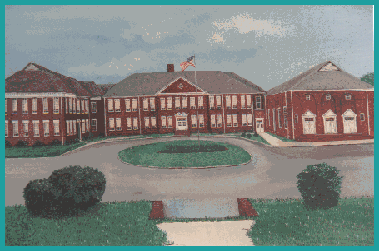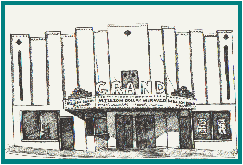

From "A New
Togetherness" by Alva W. Stewart,
North Carolina correspondent for the National
Civic Review
In 1728, English planter and aristocrat Colonel William Byrd and his surveying party entered the Dan Valley. The Crown appointed Byrd as a commissioner, with responsibility for establishing a dividing line between Virginia and North Carolina. Awed by the physical beauty of the land, Byrd wrote this entry in his diary: "This is a land rich even unto the fabled lands about Babylon. The air is wholesome, and the soil equal in fertility to any in the world." He further described it as the "Wonderful Land of Eden." In 1733 he received his grant of twenty thousand acres, and named it, "The Land of Eden," and said in his immortal book, it was the most beautiful section he had ever seen. All of Spray and Draper, and much of Leaksville were within the confines of Byrd's tract. When Leaksville's radio station, the first in Rockingham County, went on the air in December, 1946, the call letters, with perfect propriety, were WLOE, representing the "Wonderful Land of Eden."
Leaksville, the oldest and largest of the communities came into being in 1797 when the state legislature passed an act authorizing John Leak, a tanner, to lay off a town on a tract of his land on the north side of the Dan River. The town was officially incorporated in 1874.
From "Eden: Past and Present 1880-1980" by James E. Gardner, Friends of the Eden Public Library
As early as 1797 the General Assembly appointed Robert Coleman, Nathaniel Scales, Alexander Snead, Terry Hughes, and John Leak commissioners to build and improve the town of Leaksville in accordance with the plan drawn up by Abraham Philips; Leak, for whom the town was named, had already sold 45 lots in 1797 and a few houses had been erected.
A short commercial boom occurred in the period 1818-1819 when it appeared that Leaksville had won the prize as the designated navigational head of the Dan River for "bateau" traffic against the competition of Madison and Jackson, the town that was heavily promoted but never built, and Danville itself. The failure of the Jackson venture at Eagle Falls upstream of Leaksville led to quick growth here.
In 1818, a great building boom had started, a large bank was established, a branch of the state bank, and lots were sold for almost fabulous prices. In 1819, an academy was opened at Leaksville and later a school for girls was conducted. In later years, Nathan Henry, a son of America's great orator and patriot Patrick Henry, conducted the Academy for males. In 1846 Patrick Henry III was head of the school. In that year he closed the school, formed a company, and as captain of it, went to Mexico with a North Carolina regiment. Other noted teachers conducted the school here, the best known being Professor N. S. Smith and B. W. Ray.
The bubble burst in the river port scheme and from 1821 to 1883, as noted by one commentator, the town was economically somnolent and ranged in population from 250 to 300. However, in this period a major development did occur, though outside the town of Leaksville, which presaged the economic future of the area, pointing it in a direction it would irreversibly take at the end of the century: the establishment in 1837 (variably cited as 1839) of the Leaksville Cotton Mill – Morehead’s "Factory," it was called – by John M. Morehead who was to be a two-term governor, serving from 1841 to 1845. This mill operated steadily over the decades except perhaps for some lack periods associated with the Civil War.
An occasion, indeed the cause, for resurgence of economic growth in Leaksville was the
completion of a narrow-gauge railroad branch (the Danville, Mocksville, and Southwestern Line; later the Danville and Western) from Leaksville junction near Cascade to Leaksville, connecting Leaksville with Danville, Virginia. The branch was built in 1883, and the town has been improving ever since.
The Leaksville Woolen Mill began by Morehead as a modest adjunct to the cotton mill for the carding and spinning of wool from sheep raised on his own farm land. It later evolved into the weaving of blankets and cloth for commercial sale from "toll wool" received from farmers.
It was established in 1881 when the Morehead business interests were being managed by J. Turner Morehead and Company, but the major mill-building project in Spray was to come later, after the organization in 1889 of the Spray Water Power and Land Company. Leaksville Woolen was incorporated in 1903.
J. Turner Morehead described the 1884 scene of Leaksville as "The town of Leaksville is a popular and growing tobacco market. It has three warehouses for the sale of leaf tobacco, and several flourishing tobacco factories. Auction houses had opened here soon after the War Between the States, and the market held up well in competition with other points. As late as 1893, eight factories were making chewing tobacco here, and some of their brands were famous throughout the country.
The population of the town, including the cotton factory, aggregated 800. Five stores, in which all articles of general merchandise are sold, two others that sell groceries exclusively, and a millinery establishment, are among its business houses. It also contains four churches – Methodist, Baptist, Presbyterian, and Episcopalian. Since the completion of the D. M. & S. W. Railroad to Leaksville, about 9 months ago, the trade of the town has grown greatly. The town now has railroad connections with Danville."
Leaksville had also progressed politically. As Morehead proudly noted, the town had been incorporated by an act of the state General Assembly in 1874.
(To see a map of the area in 1895, click here.)
From "A New Togetherness" by Alva W. Stewart, North Carolina correspondent for the National Civic Review
In 1946 the size of Leaksville was more than doubled by annexation. The city’s corporate limits were expanded three more times in the fifties and twice in the sixties.

Leaksville High School
Illustrated by Sheralene ThompsonThe consolidation of the three towns of Leaksville, Spray and Draper did not come easy. The first vote on the issue, on March 31, 1959 was defeated. Spray voted in favor, Leaksville and Draper against. In Leaksville the margin was almost 3 to 1 (973-374) and in Spray it was not as lopsided (317-288), but still a victory for foes for consolidation. The sentiment swung in favor of consolidation, according to a political leader, when an appeal was made to the Jaycees and younger voters. In the second vote (Sept. 12, 1967) the issue carried by a substantial majority in Spray and Draper, but by only 3 votes in Leaksville. The combined vote was 2,259 to 1,753.

The Grand Theater
Illustrated by Sheralene Thompson